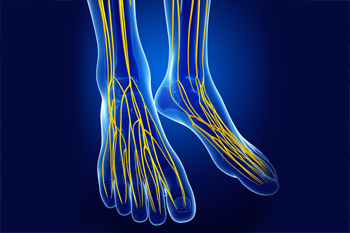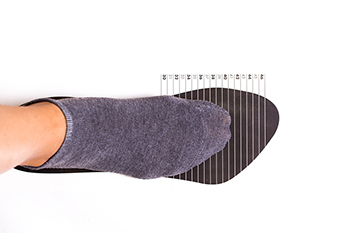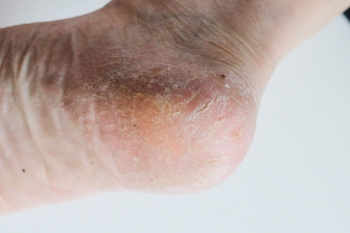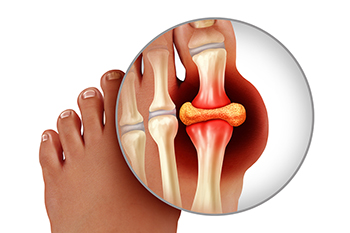
October 2024
Damage to Nerves in the Foot

Nerve damage in the foot can cause significant pain, often due to irritation of the nerves between the bones of the toes, known as interdigital nerves. This condition is commonly linked to neuromas, which are benign growths that often develop between the third and fourth toes. Factors contributing to formation of neuromas include wearing tight or non-supportive footwear, thinning of the protective fat pad at the ball of the foot, and structural abnormalities that put additional pressure on the nerves. Nerve pain in the foot starts with mild aching, tingling, or burning in the toes. However, it can progress to a constant burning sensation that makes it difficult to wear closed-toe shoes. A podiatrist can offer relief by recommending proper footwear, prescribing custom orthotics, or administering injections to reduce inflammation and pain. In more severe cases, surgery may be needed to remove the neuroma. This may provide pain relief but may also cause numbness. If you are experiencing nerve pain in your feet, it is suggested that you schedule an appointment with a podiatrist for a treatment plan that works best for you.
Neuropathy
Neuropathy can be a potentially serious condition, especially if it is left undiagnosed. If you have any concerns that you may be experiencing nerve loss in your feet, consult with Dr. Randy Garr from Bigfoot Podiatry. Our doctor will assess your condition and provide you with quality foot and ankle treatment for neuropathy.
What Is Neuropathy?
Neuropathy is a condition that leads to damage to the nerves in the body. Peripheral neuropathy, or neuropathy that affects your peripheral nervous system, usually occurs in the feet. Neuropathy can be triggered by a number of different causes. Such causes include diabetes, infections, cancers, disorders, and toxic substances.
Symptoms of Neuropathy Include:
- Numbness
- Sensation loss
- Prickling and tingling sensations
- Throbbing, freezing, burning pains
- Muscle weakness
Those with diabetes are at serious risk due to being unable to feel an ulcer on their feet. Diabetics usually also suffer from poor blood circulation. This can lead to the wound not healing, infections occurring, and the limb may have to be amputated.
Treatment
To treat neuropathy in the foot, podiatrists will first diagnose the cause of the neuropathy. Figuring out the underlying cause of the neuropathy will allow the podiatrist to prescribe the best treatment, whether it be caused by diabetes, toxic substance exposure, infection, etc. If the nerve has not died, then it’s possible that sensation may be able to return to the foot.
Pain medication may be issued for pain. Electrical nerve stimulation can be used to stimulate nerves. If the neuropathy is caused from pressure on the nerves, then surgery may be necessary.
If you have any questions, please feel free to contact our office located in Provo, UT . We offer the newest diagnostic and treatment technologies for all your foot care needs.
How to Accurately Measure Your Foot Size

Measuring your foot size correctly is essential for finding well-fitting shoes and ensuring comfort. Begin by placing a piece of paper on a flat surface against a wall. Stand with your heel on the paper against the wall and your weight evenly distributed. Trace the outline of your foot on the paper, making sure to keep the pen or pencil perpendicular to the paper. Measure the length from the heel to the tip of the longest toe, and record this measurement. To determine the width, measure the widest part of your foot. It is best to measure your feet at the end of the day when they are most swollen. Compare these measurements with a shoe size chart to find your correct size. If you have sustained a foot affliction from wearing shoes that do not fit properly, it is suggested that you consult a podiatrist who can treat various foot ailments, and educate you on how to correctly measure your feet.
Getting the right shoe size is an important part of proper foot health. Seek the assistance of Dr. Randy Garr from Bigfoot Podiatry. Our doctor will provide the care you need to keep you pain-free and on your feet.
Getting the Right Shoe Size
There are many people who wear shoes that are the incorrect size, negatively affecting their feet and posture. Selecting the right shoes is not a difficult process, so long as you keep several things in mind when it comes to choosing the right pair.
- When visiting the shoe store, use the tools available to measure your foot.
- Be sure there is ‘wiggle room’. There should be about an inch between your toes and the tip of your shoes.
- Do not always assume you are the same size, as manufacturers run differently.
- Purchase shoes later in the day, as your feet swell as the day progresses.
- If a shoe is not comfortable, it is not suitable. Most shoes can’t be ‘broken in’, and comfort should be the ultimate goal when it comes to choosing the right pair of shoes
As our feet hold our body weight and keep us moving, it is important to treat them right. Picking the right pair of shoes can provide your feet comfort and mobility without pain.
If you have any questions, please feel free to contact our office located in Provo, UT . We offer the newest diagnostic and treatment technologies for all your foot care needs.
Definition and Causes of a Bunion

Bunions are bony protrusions that form at the base of the big toe, often causing the tip of the toe to angle toward the other toes. Symptoms typically include pain, swelling, and redness around the joint, which may worsen with prolonged standing or walking. Bunions often develop due to genetic factors, improper footwear, or abnormal foot mechanics. Wearing tight or high-heeled shoes can worsen the condition by putting pressure on the toe joint. Diagnosing bunions usually involves a physical examination and may include X-rays to assess the extent of bone displacement and joint damage. For severe cases, surgical options may be considered to correct the deformity and alleviate pain. If you have symptoms of a bunion, it is suggested that you schedule an appointment with a podiatrist who can suggest treatment methods that are right for you.
If you are suffering from bunions, contact Dr. Randy Garr of Bigfoot Podiatry. Our doctor can provide the care you need to keep you pain-free and on your feet.
What Is a Bunion?
A bunion is formed of swollen tissue or an enlargement of boney growth, usually located at the base joint of the toe that connects to the foot. The swelling occurs due to the bones in the big toe shifting inward, which impacts the other toes of the foot. This causes the area around the base of the big toe to become inflamed and painful.
Why Do Bunions Form?
Genetics – Susceptibility to bunions are often hereditary
Stress on the feet – Poorly fitted and uncomfortable footwear that places stress on feet, such as heels, can worsen existing bunions
How Are Bunions Diagnosed?
Doctors often perform two tests – blood tests and x-rays – when trying to diagnose bunions, especially in the early stages of development. Blood tests help determine if the foot pain is being caused by something else, such as arthritis, while x-rays provide a clear picture of your bone structure to your doctor.
How Are Bunions Treated?
- Refrain from wearing heels or similar shoes that cause discomfort
- Select wider shoes that can provide more comfort and reduce pain
- Anti-inflammatory and pain management drugs
- Orthotics or foot inserts
- Surgery
If you have any questions, please feel free to contact our office located in Provo, UT . We offer the newest diagnostic and treatment technologies for all your foot care needs.
Causes and Relief for Cracked Heels

Cracked heels, or heel fissures, are a common foot problem where the skin on the heels becomes dry, thickened, and splits. These cracks can cause discomfort and pain, especially while standing or walking, and they can sometimes lead to infection if left untreated. Heel fissures occur when the skin loses moisture, leading to dryness and reduced elasticity. Contributing factors include prolonged standing, wearing open-backed shoes, obesity, and conditions like diabetes or eczema, which can cause dryness. Relief involves moisturizing the feet regularly with thick emollients or foot creams containing urea or lactic acid to soften the skin. In more severe cases, medical treatment may be necessary, such as debridement or the application of special wound dressings. If you have severely cracked heels, it is suggested that you schedule an appointment with a podiatrist for an examination and treatment.
Cracked heels are unsightly and can cause further damage to your shoes and feet. If you have any concerns, contact Dr. Randy Garr from Bigfoot Podiatry. Our doctor can provide the care you need to keep you pain-free and on your feet.
Cracked Heels
Cracked heels appear unappealing and can make it harder for you walk around in sandals. Aside from looking unpleasant, cracked heels can also tear stockings, socks, and wear out your shoes. There are several methods to help restore a cracked heel and prevent further damage.
How Do You Get Them?
Dry skin is the number one culprit in creating cracked heels. Many athletes, walkers, joggers, and even swimmers suffer from cracked heels. Age and skin oil production play a role to getting cracked heels as well.
Promote Healing
Over the counter medicines can help, especially for those that need instant relief or who suffer from chronic dry feet.
Wear Socks – Wearing socks with medicated creams helps lock in moisture.
Moisturizers – Applying both day and night will help alleviate dryness which causes cracking.
Pumice Stones – These exfoliate and remove dead skin, which allows for smoother moisturizer application and better absorption into the skin.
Change in Diet
Eating healthy with a well-balanced diet will give the skin a fresh and radiant look. Your body responds to the kinds of food you ingest. Omega-3 fatty acids and zinc supplements can also revitalize skin tissue.
Most importantly, seek professional help if unsure how to proceed in treating cracked heels. A podiatrist will help you with any questions or information needed.
If you have any questions, please feel free to contact our office located in Provo, UT . We offer the newest diagnostic and treatment technologies for all your foot care needs.
Do Your Child's Feet Hurt?
When Is Surgery Needed for Gout?

Gout is a form of arthritis that commonly affects the feet, particularly the big toe, and can often be controlled with medications and lifestyle changes. However, when gout progresses and causes significant joint damage or chronic pain, surgery may be necessary. Surgery for gout is typically considered when uric acid deposits, called tophi, form around the joints and lead to severe pain, deformities, or infections. The three main types of surgery are tophi removal, joint fusion, and joint replacement. Tophi removal involves cutting out the painful deposits while preserving healthy tissue. Joint fusion stabilizes the bones to relieve pain but may reduce mobility. Joint replacement, used in more advanced cases, involves putting in an artificial joint to improve function and reduce discomfort. A podiatrist can help determine the most appropriate gout treatment based on the severity of the condition. If you have chronic pain from gout, it is suggested that you schedule an appointment with a podiatrist wh can determine if surgery is needed.
Gout is a foot condition that requires certain treatment and care. If you are seeking treatment, contact Dr. Randy Garr from Bigfoot Podiatry. Our doctor will treat your foot and ankle needs.
What Is Gout?
Gout is a type of arthritis caused by a buildup of uric acid in the bloodstream. It often develops in the foot, especially the big toe area, although it can manifest in other parts of the body as well. Gout can make walking and standing very painful and is especially common in diabetics and the obese.
People typically get gout because of a poor diet. Genetic predisposition is also a factor. The children of parents who have had gout frequently have a chance of developing it themselves.
Gout can easily be identified by redness and inflammation of the big toe and the surrounding areas of the foot. Other symptoms include extreme fatigue, joint pain, and running high fevers. Sometimes corticosteroid drugs can be prescribed to treat gout, but the best way to combat this disease is to get more exercise and eat a better diet.
If you have any questions please feel free to contact our office located in Provo, UT . We offer the newest diagnostic and treatment technologies for all your foot and ankle needs.






